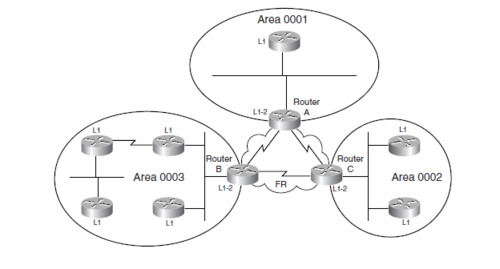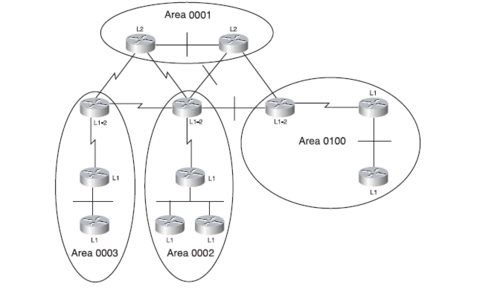Difference between revisions of "IS-IS"
m (→Links) |
m (→Example) |
||
| Line 20: | Line 20: | ||
= Configuration = | = Configuration = | ||
== Example == | == Example == | ||
| − | < | + | <source lang=cli> |
interface Loopback0 | interface Loopback0 | ||
ip address 192.168.100.12 255.255.255.255 | ip address 192.168.100.12 255.255.255.255 | ||
| Line 33: | Line 33: | ||
is-type level-2-only | is-type level-2-only | ||
metric-style wide | metric-style wide | ||
| − | </ | + | </source> |
| + | |||
=ISIS and default-information = | =ISIS and default-information = | ||
ISIS level 2 default announce 0.0.0.0 regardless of the network appears in the Routing table. To avoid this use a Route-map | ISIS level 2 default announce 0.0.0.0 regardless of the network appears in the Routing table. To avoid this use a Route-map | ||
Revision as of 09:40, 17 August 2010
Contents
Intermediate-System to Intermediate-System
IS-IS is a link state Routing protocol which are also used in IP network. Here it is called integrated IS-IS. IS-IS is often used by providers as an IGP.
Level 1 Routing
A level 1 Router only knows about the area in which it is located. Like a stub Router in OSPF. It has no knowledge of other areas. A level 1 Router only knows a default Route to the nearest level 2 Router if Routing between areas is necessary. Every Level 1 Router in that area has the same link State Database containing information about that area.
Level 1 Routers are referred to as Intra-area Routers
Level 2 Routing
A Level 2 Router routes between areas and are referred to as Backbone Routers. The backbone must be contiguous because all Level 2 Routers share the same Link-State Database which contain prefixes from all areas. If the backbone is fractured Routing information will not be the same on all Level 2 Routers.
Level 2 Routers are referred to as Inter-area Routers
Level 1-2 Routers
The Level 1-2 Router has both the Level 1 Link-state database containing information about the area in which it participates and Level 2 Link-state database containing information about all areas.
Point-to-point link Adjacencies
If a Point-to-Point link connects two Routers the Routers are neighbors and each side send a CSNP - Complete Sequence Number Packet - which is a packets containing the Link State database to each other.
Broadcast links Adjacencies
On broadcast link medias, for example Ethernet, all Routers receive receive LSP - link State packets - from one router the DIS - Designated Intermediate system. The DIS Router has the responsibility to flood LSP's to all connected IS-IS Routers on behalf of the pseudonode.
Pseudonode
The pseudonode is a virtual Router that represents the LAN. All IS-IS Routers participating on the LAN simulate an interface on the imaginary Router. This imaginary Router is called the pseudonode. The pseudonode floods LSP's to all participating Routers. In the real world it is the DIS who sends LSP packets. The DIS is elected from the priority on the interface which defaults to 64. If all priorities are the same the DIS is elected as having the highest SNPA (Data-link address)
Configuration
Example
interface Loopback0
ip address 192.168.100.12 255.255.255.255
ip router isis
!
interface fastethernet 0/0
ip address 83.90.2.3 255.255.255.0
ip router isis
!
router isis
net 49.0000.1921.6810.0012.00
is-type level-2-only
metric-style wideISIS and default-information
ISIS level 2 default announce 0.0.0.0 regardless of the network appears in the Routing table. To avoid this use a Route-map
interface FastEthernet0/1
description internet access
ip address dhcp
ip nat outside
!
router isis
mpls traffic-eng router-id Loopback0
mpls traffic-eng level-2
net 49.0000.0101.3300.3333.00
is-type level-2-only
metric-style wide
default-information originate route-map Internet
!
access-list 10 permit any
!
route-map Internet permit 10
match ip address 10How Route Summarization Can Enhance Scalability in IS-IS Networks
Summarization is a key factor that affects the scalability of a routing protocol. Summarization reduces the number of routing updates that are flooded across areas or routing domains. Especially for multi-area IS-IS, a good addressing scheme can optimize summarization by not allowing an overly large Level 2 database that is unnecessarily populated with updates that have come from Level 1 areas.
A router can summarize prefixes on redistribution whether the prefixes have come from internal prefixes, local redistribution, or Level 1 router redistribution. Routes that have been leaked from Level 2 to Level 1 and routes that are advertised into Level 2 from Level 1 can also be summarized.
Router(config-router)#<input>summary-address 1.0.0.0 255.0.0.0 ?</input>
level-1 Summarize into level-1 area
level-1-2 Summarize into both area and sub-domain
level-2 Summarize into level-2 sub-domain
<cr>
